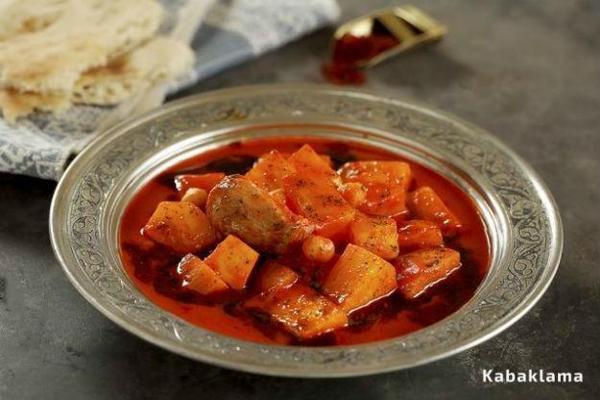Stews & stories
Aylin Öney Tan - aylinoneytan@yahoo.com


The story is about a groom and a wedding which almost turned into a disaster. It is a story remembered and recited every time a dish of kabaklama appears on the table. Kabaklama, a humble stew of winter squash and lamb, is so well-liked that it has become a traditional wedding dish in Gaziantep. There is nothing elaborate about it; on the contrary, it is like any other tasty stew of the town, except for maybe the use of a pale, yellowish, white-fleshed winter squash that makes the whole difference. That particular wedding, there was a miscalculation and there was not enough kabaklama for everyone. It was gone before it was served to the groom, who was apparently very fond of the dish. Having left without tasting a single spoonful, the groom was very cross and stormed off, shouting, “Let whoever ate my kabaklama marry the bride and go to the nuptial chamber!”
Whether anyone really carried their love of kabaklama to such an extreme is unknown, but it is certainly one of the best-loved dishes in Gaziantep cuisine. Though when it comes to favorite dishes of Gaziantep citizens, the choices are numerous, along with the stories attached to them… The ubiquitous ezogelin soup served all over Turkey year-round is actually based on a Gaziantep recipe for lentil soup. The name derives from a story about a young girl name Ezo Gelin, the eponymous tragic bride of a traditional folktale who was sent across the border to marry a man from Syria and remained separated from her family and village for the rest of her life. Although the story itself may be based on fact, the connection with the original lentil soup is quite loose.
The soup, known as ekşili malhıta çorbası in Gaziantep, is a soup of red lentils (called malhıta in Gaziantep) and rice, spiked with coral red pepper and tomato paste, with a generous dash of lemon juice and lots of crushed garlic, freshened with copious amounts of dried mint. It is way heartier and filling compared to the subtle, smooth, strained lentil soup normally found in Istanbul eateries. When the regional variety of lentil soup from Gaziantep started to appear in Istanbul, there had to be a distinction made between the two very popular lentil soups, hence the name was coined in the 1960s by some Istanbul kebab restaurants in order to distinguish it from Istanbul-style lentil soup. Of course we still like to believe that this was the favorite soup of the poor bride who probably had shed cups of tears along with lemon juice to add to the salty tang of the soup, popular with the poor even for breakfast.
In Gaziantep such stories are told for almost all dishes. Besides commonly shared culinary legends, everybody seems to have their own family stories. Gaziantep Mayor Fatma Şahin has a giggly, girlish charm when she starts to talk about the food of Gaziantep and she definitely has her own stories. Her husband is not from Gaziantep, but from the eastern city of Malatya, another town with an outstanding cuisine. When they decided to get married, the family of her future husband visited her family to ask for their vow for the marriage. Everything goes fine; the families enjoy a joyful dinner together, but just as everything is going perfectly well, the groom’s side comments on the food: The soup was amazing!
All of sudden there were almost visible icicles hanging in the air.
Young Fatma desperately whispered to her future husband: “It is not a soup; it is yuvarlama, our most important dish. To call it a soup is considered an insult!”
The soupy stew of the tiniest rice dumplings cooked to perfection with chickpeas and small lamb cubes, all wonderfully blended with tangy creamy yogurt with a splash of the greenest mint infused in warm butter, is definitely to die for. It is the iconic dish of Gaziantep, and I bet every family has their own stories related to yuvarlama. It surely has its place in Şahin’s family history. Their marriage was put at risk just by misnaming that Gaziantep favorite!
Gaziantep is a town with stories, and stories are intangible carriers of tradition, like invisible umbilical cords feeding the future with the richness and bounty of the past. The delicate stews of Gaziantep cookery not only taste incredible, but they whisper to us stories from centuries ago…
Bite of the Week

